For most of the field’s history, the bulk of paleontological research has occurred in North America, a fact reflected in the average dinosaur shelf lineup. There’s certainly no shortage of figures representing classics like Tyrannosaurus, Triceratops, and Stegosaurus, while more obscure species from elsewhere in the world languish in the shadows. However, the rise of new discoveries from once (paleontologically) neglected regions of the world is slowly turning the tide. Kaiyodo’s latest CQ set features prehistoric animals (some only recently discovered) known from the company’s native Japan. The collection consists of five figures: Tambatitanis, Fukuiraptor, a therizinosaurid, Pteranodon, and the crocodilian Toyotamaphimeia.
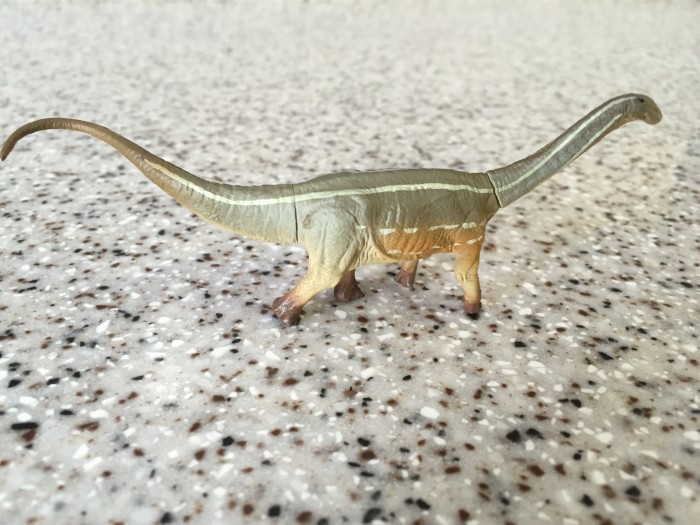
First up is Tambatitanis, from the early Cretaceous of Japan. Initially discovered in 2006, this species was only described very recently in 2014. Known from partial remains, many of this species’ distinguishing features are aspects of the bones (particularly the vertebrae) that wouldn’t be visible in the living animal. However this figure is an accurate depiction of a generic sauropod, with ample flesh and soft tissue (unlike some sauropod depictions with glaringly gaunt necks). The hands correctly have a single claw – while later titanosaurs lost this claw altogether, more basal forms like Tambatitanis still retained it. As is standard for Kaiyodo’s offerings, the level of detail packed into this small (4.25″, or just under 11 cm) figure is superb. The skin is folded and wrinkled without appearing elephantine, and small details such as the eyes and claws are applied precisely. While the color palette isn’t particularly vibrant, the stripes and dappling add visual interest to what would otherwise be a dull figure.
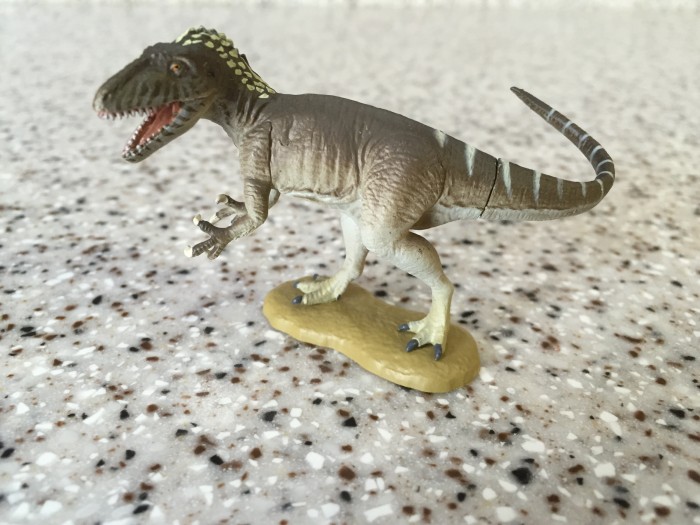
Next is Fukuiraptor, a megaraptoran also from early Cretaceous Japan. Kaiyodo has previously produced figures of this genus a few times, but their latest depiction is a departure from their usual orange and black portrayal. Only known from fragmentary remains, not much can be said as to the figure’s accuracy besides the fact that it is a realistic interpretation of a generic megaraptoran, including the enlarged hand claws (which are interestingly painted white). Once again, the use of patterning, most prominent on the jaws and the white osteoderms along the neck (appearing almost mane-like), makes for a striking appearance.
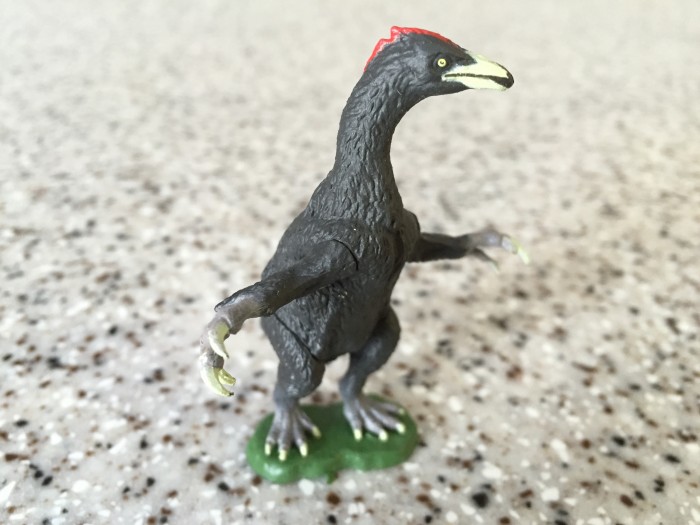
This next figure is actually quite unusual in that it is not intended to represent a specific genus but rather a generic therizinosaurid (the informational packet labels it simply as Therizinosauridae, the clade containing the classic Therizinosaurus amongst others). Only very fragmentary therizinosaur remains are reported from Japan, but given the group’s prevalence in the rest of Asia it’s reasonable to assume they were a presence in Cretaceous Japan. This figure properly represents all the classic therizinosaur anatomical traits. The hallux (first toe) is enlarged and weight-bearing, and the body is covered in primitive, down-like feathers (known from early therizinosaurs like Beipiaosaurus). The feet are not plantigrade (all the foot bones flat on the ground). Trackway finds suggest larger therizinosaurs may have been plantigrade, but the evidence isn’t definitive either way so the standard digitigrade (walking on only the toe bones) depiction is perfectly plausible. Interestingly the color scheme is rather reminiscent of an ivory-billed woodpecker (Campephilus principalus), an impression furthered by the pine green base.

Those of you in the know may now be having mental alarm bells going off: “Isn’t this set called dinosaurs of Japan? This is no dinosaur! And since when is Pteranodon Japanese?”. Indeed, this is the quintessential pterosaur Pteranodon longiceps. Japanese pterosaur remains have been attributed to Pteranodon, but given Japan’s distance from the American Western Interior Seaway (Pteranodon‘s primary habitat) this identification is unlikely. Perhaps Kaiyodo saw the need to include at least one iconic genus in their set – given the obscurity of the other genera included this is excusable. This is a familiar face in more ways than one – it’s the same model that appeared in Kaiyodo’s 2015 Cretaceous Collection. The notable difference is in the color scheme – this Pteranodon is primarily various shades of white and pink, a fate usually reserved for the bristle-toothed pterosaur Pterodaustro (if you don’t believe me a quick Google Image search will show what I mean). In fact, when combined with the grey beak the colors are remarkably similar to those of a roseate spoonbill (Platalea ajaja) – seems like Kaiyodo has been pulling heavily from extant animals for inspiration with this set. Something worth mentioning is that the plastic used for these figures is softer than that of Kaiyodo’s previous Dinotales figures, meaning protruding features like the Pteranodon‘s beak and crest are susceptible to bending during shipping – manually applying force in the opposite direction should correct any warping.
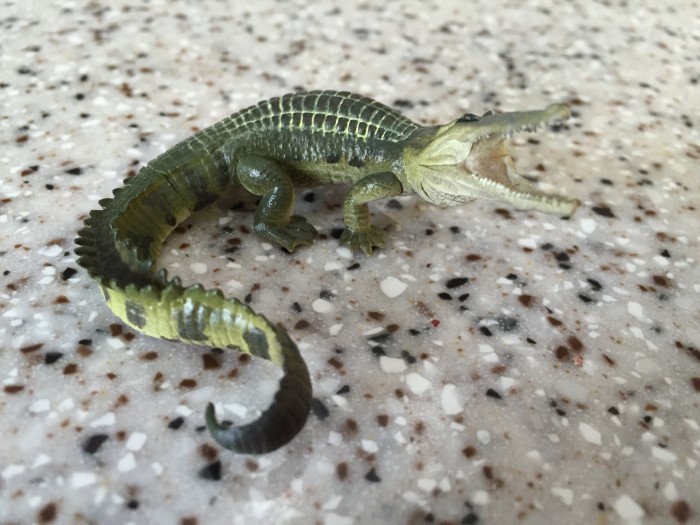
Last up is another non-dinosaur, the crocodylian Toyotamaphimeia. Not only is it not a dinosaur, it’s not even Mesozoic! It lived 450,000 years ago, during the Pleistocene, and was a close relative of the modern false gharial (in fact it was once considered to be in the same genus, Tomistoma). Toyotamaphimeia‘s remains are actually rather well-known, and the figure represents it accurately. Like its modern relative, the snout widens towards the base of the head, the feet are webbed with the correct number of toes, the caudofemoralis muscle at the base of the tail is sufficiently thick, and the inside of the open mouth is even a very pale pink color like seen in extant crocodilians. Once again the detail is superb, with distinct scales and scutes present all over the body.
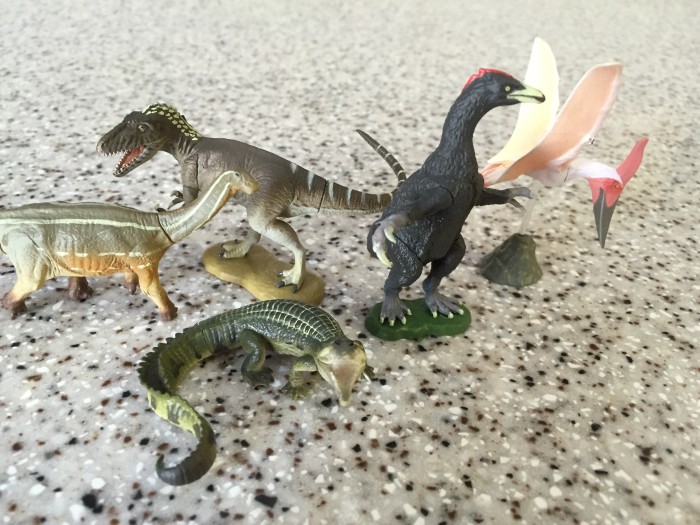
Overall this is another set of accurate, well-detailed, and interestingly colored figures from Kaiyodo. Though not all the depicted animals are necessarily dinosaurs or Japanese, this group of figures establishes an excellent precedent for released sets of mostly obscure genera, offering superb depictions of rarely represented animals. In fact, the Toyotamaphimeia is the first figure of its genus ever made (Fukuiraptor and Tambatitanis come in at third and second respectively)! Like the previous Cretaceous Collection set, these figures don’t have the tiny accompanying human figures included in earlier CQ sets, something I actually prefer (keeping the human figures matched up with their respective animals gets to be a bit nerve-wracking on a jumbled collection shelf). This is a must-have set for any lover of obscure prehistoric creatures, and I highly recommend it to Kaiyodo fans and those who collect smaller figures in general. It can be found on eBay or obtained by services that purchase directly from Japan.
Disclaimer: links to Ebay and Amazon on the DinoToyBlog are affiliate links, so we make a small commission if you use them. Thanks for supporting us!




The color of the Pteranodon seems to refer to Toki (Nipponia Nippon), a symbol of Japan, which is an endangered species.
I bet you’re right! Wouldn’t be the first time Kaiyodo gave one of their prehistoric animals the colors of an iconic Japanese animal.
The therizinosaur is my favourite by far. A really interesting and unusual take.